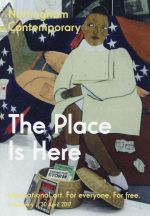Black artists in 1980s Britain
Since the publication of Shades of Black: Assembling Black Arts in 1980s Britain in 2005, there have been a number of exhibitions that have singled out the 1980s as a special decade with regards to black artistic practice. In 2011–12 Tate Britain’s Thin Black Line[s] re- staged three exhibitions organised during the 1980s by Lubaina Himid, while in 2011 Graves Art Gallery in Sheffield offered its own retrospective view with BLK Art Group 1983–1984. Furthermore, Tate Liverpool’s Afro Modern: Journeys through the Black Atlantic in 2010, No Colour Bar: Black British Art in Action 1960–1990 at London’s Guildhall Art Gallery in 2015 and last year’s Black Art in Focus at Wolverhampton Art Gallery have, in various ways, drawn attention to the 1980s.
The Place Is Here at Nottingham Contemporary is the latest and the largest exhibition on the work of black British artists in that decade. In fact, in many ways it is the show that Shades of Black never was, since the earlier project materialised only as a conference and book. However, like its progenitor, the current exhibition raises more questions than it answers. The enduring legacy of Thatcherism, the inner city riots, the miners’ strike, AIDS and Section 28 go some way to explaining the appeal for looking back at the politics of the 1980s. While this is fertile ground, why a black artists’ show and why now? Nostalgia? Or does today’s absence of oppositional politics and counterculture ne- cessitate recycling the past? How does such a show relate to a mainstream gallery that is still reticent in its support for all but a handful of black British artists?
The Place Is Here brings together painting, sculpture, photography, printmaking and video produced by over thirty artists and collectives, and we are told by the organisers that it ‘evokes some of the urgent and wide-ranging conversations taking place between black artists, writers, thinkers and institutions in the UK in the 1980s, which explored identity and representation, racism and colonial legacies’. As the first generation of British-born black artists emerged from Britain’s art schools, they became involved in an unprecedented explosion of visual arts activity in the 1980s, exhibiting in public galleries, shops, theatres and artists’ studios in London and beyond. The exhibition presents a significant number of works produced by artists during the formative stages of their art schooling or careers…
More +
Excerpt from 'The Place is Here' Nottingham Contemporary
4 February – 1 May 2017, The Burlington Magazine, April 2017, No. 1369 – Vol 160]
